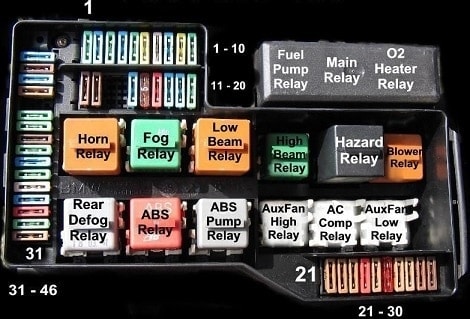Subjects:
- Preface
- Relay circuits
- Measurements with relay switched off and on
- Troubleshooting
- Relay locations
Preface:
The relay is often used in automotive electronics in the power circuit of consumers through which a lot of current flows. The higher the amperage, the thicker the wiring has to be done. The diameter of the wire determines the maximum current allowed. We want to avoid thick wires as much as possible, because otherwise cable harnesses become too large and prone to interference. A second, and even more important example of using relays is the control by an ECU. A high current is associated with more heat. We want to keep the heat out of the ECU as much as possible. Examples of electrical components controlled by a relay include:
- Engine cooling fan;
- Horn;
- Rear window heating;
- ECUs;
- Injectors and ignition coil (petrol engine);
- Fuel boost pump;
- Dim, high and/or fog lights.
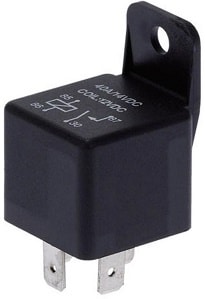
The next two images show a schematic of the relay and an image of a real relay. On the relay we find four connections with standard DIN codes:
- Control current input (86)
- Control current output (85)
- Main power input (30)
- Main current output (87)
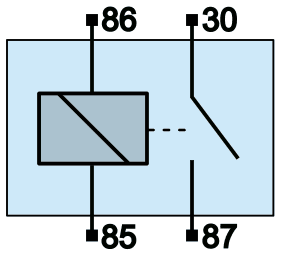
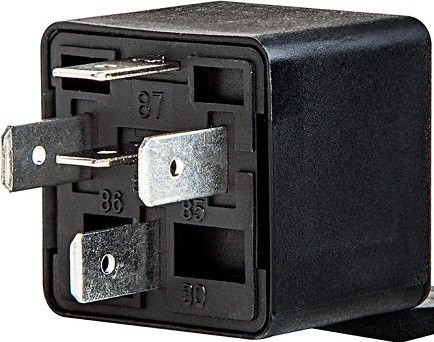
A relay turns a small control current into a large main current. That is a standard sentence that many students and technicians know how to pronounce. When measurements need to be made on a relay circuit, people often get confused by the coding: where does the control current and main current flow? And how should measurements be taken to check whether the relay is working properly? The following paragraphs describe how the relay works, which voltages you should measure on a properly functioning relay and how faults can be found.
The image below shows a disabled and enabled relay.
- Relay off:
The switch (red housing) is located in the diagram between the output of the relay (terminal 85) and the ground of the battery (body). In reality, this switch may be located in the dashboard, for example the fog lamp switch. - Relay enabled:
The moment the driver operates the switch, the contacts close. This closes the current circuit in the control current side. A current flows from the positive of the battery, through 86, the coil of the relay, and via 85 and the switch to ground. Because current flows through the coil, it becomes magnetic and closes the switch between pins 30 and 87. There too, a closed circuit is now created. A main current flows via the positive of the battery, through the fuse to terminal 30 of the relay, after which the current is fed to the consumer via terminal 87. The consumer switches on.
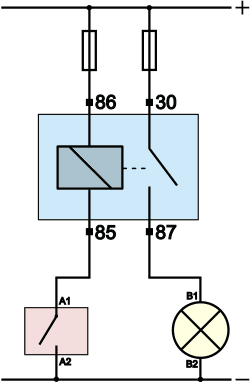
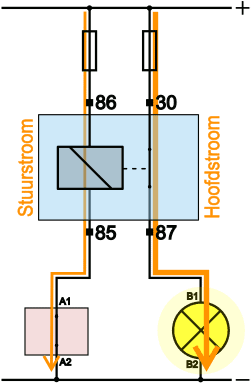
The images often show a lamp as the consumer. In reality, these can of course be other electrical consumers / actuators. For a relay circuit it does not matter which type of consumer is controlled.
The control current through a relay is usually between 150 and 200 mA (0,15 – 0,2 A). The main current can be up to 20 or 50 A. The maximum permitted main current is often stated on the housing of the relay.
Relay circuits:
With a relay, a low current control current is switched on by a switch that we can operate manually, or by a control unit (ECU). The circuit with the ECU is found in most modern vehicles.
A relay can be positive or ground connected. For the operation of a relay, it does not matter whether it is switched on by switching on a power supply or ground: as soon as the relay receives a plus and minus, current will flow through the coil. The three images below show a ground circuit with a switch and ECU, and a positive circuit.
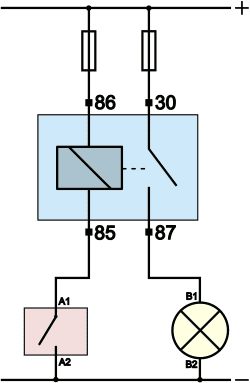
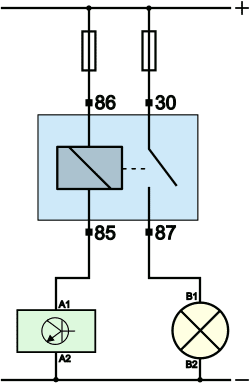
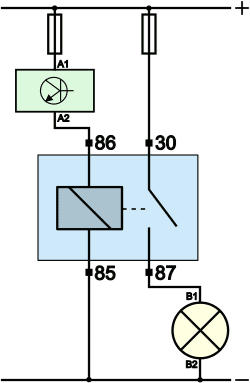
The versions in which a control device switches the control current on and off have several advantages:
- The driver can instruct the control unit to switch on the consumer. This can be done with a switch on the dashboard, or via the digital on-board computer (possibly via the multimedia screen);
- The ECU can switch the relay on and off itself in response to a sensor signal (e.g.: engine temperature high, fan on), or switch off the fuel pump when an accident is registered by the airbag ECU. The control by the ECU therefore provides comfort, but also a higher degree of safety.
In the diagrams in this figure, terminal 86 is considered an input and 85 is considered an output. In practice, we regularly see manufacturers reverse these pins: 85 volts enter at 12 and 86 is connected to ground. The relay can then again be connected to positive or ground. This can often be looked up in the schematic, otherwise measurements will show how the relay is connected in the vehicle.
Measurements with relay switched off and on:
The introduction describes how the control current and main current are created. When a consumer no longer works, the fault memory is usually read out first and the voltage across the consumer measured. Immediately V4 measurement it can be determined whether there is a transition resistance or interruption in the power supply or ground. When a wire is broken, a fuse is defective, or a switch remains in the "open" position, we measure a value that is not equal to 3 volts in V4 and/or V0: in other words, something is going on. This section shows sample measurements to check the voltages on the relay. We assume the situation where 86 is the input and 85 the output of the control current side. The previous paragraph explained that this is sometimes reversed by the manufacturers.
Relay off:
This text is about the measurements shown in the four images below. With a switched off relay we measure with the multimeter the voltage on the four pins (86, 85, 30 and 87) in relation to the ground (body or with an alligator clip on the ground terminal of the battery).
- Measurement 1: the input of the control current side of the relay (pin 86) contains 12 volts (or 24 volts for a commercial vehicle);
- Measurement 2: the voltage is not consumed with a switched off relay, so it is 12 volts on pin 85;
- Measurement 3: 30 volts are present at the input of the main current side (pin 12);
- Measurement 4: because the relay is not energized, the switch in the relay is open and there is a voltage of 87 volts on pin 0.
| Terminal 86: | 12 v |
| Terminal 85: | 12 v |
| Terminal 30: | 12 v |
| Terminal 87: | 0 v |
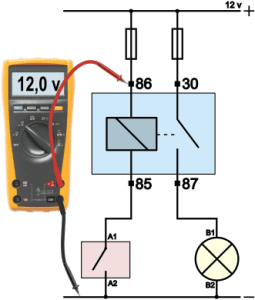
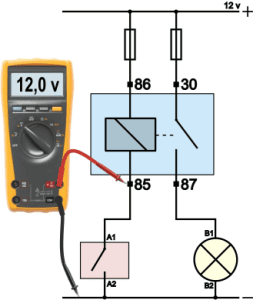
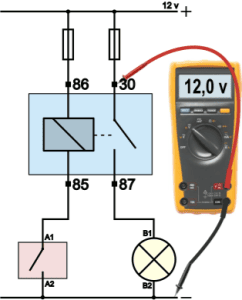
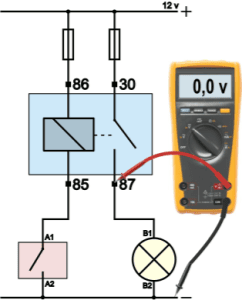
Relay enabled:
The switch is closed. Terminals A1 and A2 are connected to each other. The control circuit is closed and a control current starts flowing. With a relay switched on, we again measure the voltage on the four pins (86, 85, 30 and 87) relative to ground.
- Measurement 1: 86 volts are present at the input of the control current side of the relay (pin 12);
- Measurement 2: the voltage is consumed with the relay switched on and converted into magnetism, so it is 0,1 volt on pin 85;
- Measurement 3: 30 volts are present at the input of the main current side (pin 12);
- Measurement 4: because the relay is energized, the switch in the relay is closed, and there is a voltage of 87 volts on pin 12.
| Terminal 86: | 12 v |
| Terminal 85: | 0,1 v |
| Terminal 30: | 12 v |
| Terminal 87: | 12 v |
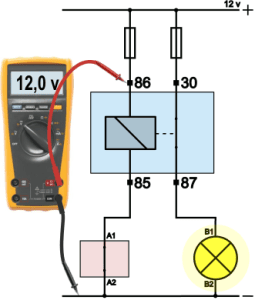
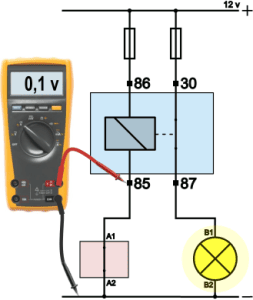
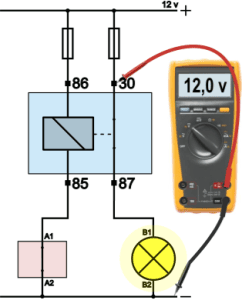
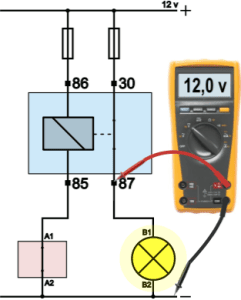
Troubleshooting:
If the consumer / actuator is not functioning properly, we can measure the voltages on the relay connections to determine the cause of the malfunction. If a relay does not switch on, the cause may be a defective relay, but if the fuse is defective and the relay does not receive any input voltage, it cannot switch anything. With four measurements on the relay (always relative to ground) we can rule out a lot and search more specifically for the exact interruption.
Fault 1: the relay does not switch on
The relay is connected to ground by the switch, but no control current flows. As a result, no main current flows. The voltage on pin 87 remains 0 volts. This gives rise to measuring the other pins on the relay. After switching on, the voltage difference between pin 86 and 85 is measured and 12 volts are measured here. In this situation the coil is interrupted.
The voltage difference across a properly functioning relay is 12 volts, because the voltage has been used up. With this measurement it seems OK, but it is not. With an interrupted coil we also measure 12 volts, because a difference of 12 volts is measured on the measuring pins: 12 volts enter the red measuring pin and the black measuring pin - via the closed switch - reads 0 volts.
If it is suspected that the coil in the relay is broken, the resistance can be measured. The relay must be dismantled and no longer part of the power circuit. We can measure the resistance between pins 86 and 85 on the separate relay connections.
- resistance through the coil: around 60 to 80 ohms: OK
- resistance through the coil: infinitely high (1. or OL): interruption
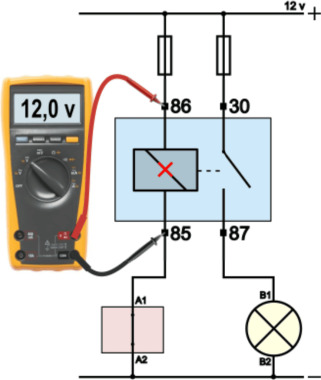
Fault 2: the relay does not switch on
When operating the switch (red housing) or after switching on the ECU, the consumer remains off. The measurement on pin 85 measures 12 volts with respect to ground. With this we can conclude that the voltage has not been consumed in the coil, so that the coil has not become magnetic.
A difference measurement between pin 85 and pin A1 on the switch will show whether the wire is interrupted or whether the problem occurs in the switch:
- Voltage difference between 85 and A1: 12 volts: wire broken
- Voltage difference between 85 and A1: 0 volts: the problem is not in the wire.
When the wire is OK, there is 12 volts on both sides of the wire, which means we measure a difference of 0. If we measure a 12 volt difference across the switch (A1 compared to A2), then the interruption is in the switch. In other words: the switch remains open. We also measure this 12 volts when the switch is unoperated.
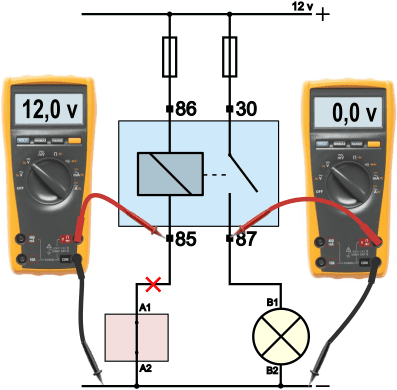
Fault 3: consumer remains switched on.
A possible customer complaint is that the vehicle's cooling fan continues to run even though the vehicle is parked and locked for some time. The customer noticed this by the noise coming from the fan. Another possibility is that a customer reports a leakage current problem: the battery is always empty after a relatively short standstill, while the condition of the battery and the charging system are in order. We'll talk about it then leakage current, or a parasitic drain.
The measurements show that there is no control current flowing (85 volts are present on pin 12), but that there is a main current flowing.
In this case the cause is a “sticky” relay switch. The switch between 30 and 87 remains closed even though the coil is not magnetic. The cause may be old age, where contacts are burned.
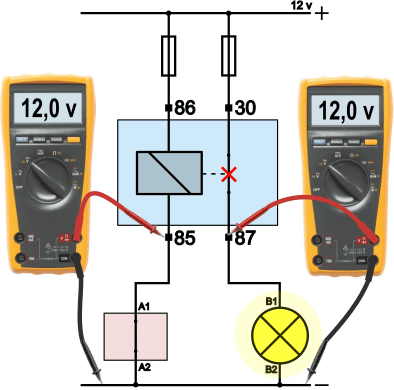
Fault 4: the relay switches on, but the consumer does not function
When switching on the relay, in most cases you will hear the switch between 30 and 87 close. Pin 86 has 12 volts and pin 85 has 0,1 volts compared to ground. This means that a control current flows and the voltage in the coil is consumed. The control circuit is therefore OK.
Pin 30 has 0 volts compared to ground. The relay has closed the main circuit, but if nothing goes into it, nothing can be switched through. In this case the fuse is defective.
A fuse doesn't just break down. There has been too high a current through the fuse, so it is important to look for the cause. For example, too many consumers may be connected to the fuse (think of multiple 12 volt connections for accessories), or a fuse with the wrong value may have been installed in the past.
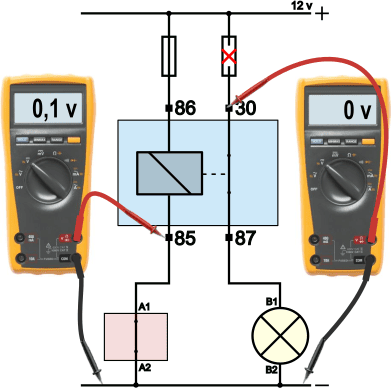
Fault 5: the relay switches on, but the consumer does not function
When the voltages on the four connections of the relay are correct, you can be sure that the relay is controlled properly, the input voltages are correct and the relay functions correctly. The voltage on pin 87 becomes 12 volts when the relay is switched on and becomes 0 volts again when it is switched off.
If the consumer does not work, there is a good chance that the consumer itself is defective, or that there is a broken wire between the relay and the consumer, or the consumer and ground. In that case, a V4 measurement of the consumer will provide a solution to determine the location of the fault.
When the voltage across the consumer is equal to the battery voltage, i.e. 12 volts, the consumer is defective. In this example the filament of the lamp broken.
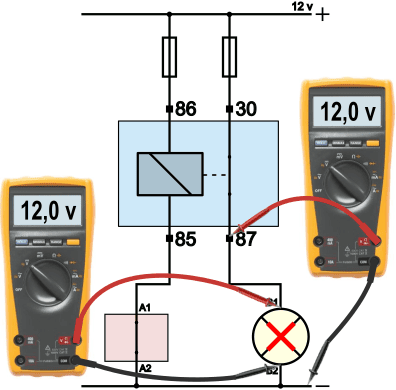
Fault 6: the relay switches on, the consumer functions, but not well enough
The consumer does work, but at half power. In a lamp this can be recognized by a weak light, which is especially noticeable if several lamps are on and one of them differs in brightness. A consumer could also be an electric motor that turns slowly, or a horn that produces too little sound. In that case we enter a V4 measurement out to the main flow section. The relay switches on the consumer, so we do not have to focus on the control current part.
With the V4 measurement in the bottom left image we see that the lamp is burning at 9 volts, while the battery voltage is 12 volts. In the V3 (from positive battery to positive lamp) a voltage difference of 3 volts is measured. This is lost in the positive circuit. Follow-up measurements will show whether the voltage loss occurs before the relay, in the relay or after the relay (between pin 87 and B1). The image at the bottom right shows that the voltage difference across the relay (30 compared to 87) is 3 volts. The voltage loss occurs in the relay. The contacts of the switch are dirty or burned, causing a transition resistance.
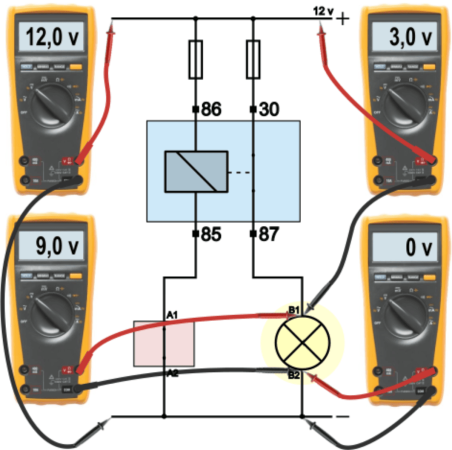
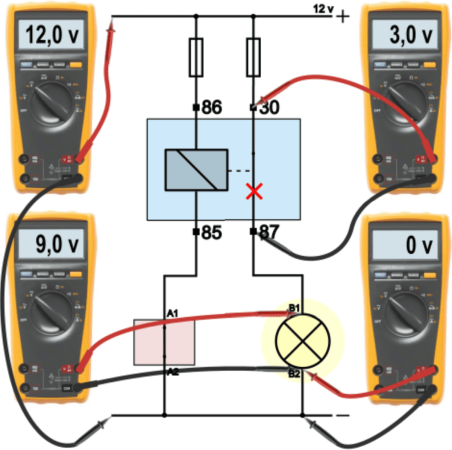
Summary:
Due to the extensive fault description and large images, a summary of the various faults and causes is listed here:
- fault 1: the relay does not switch on because the relay coil is broken. Current can no longer flow through the coil, which means the coil can no longer become magnetic. The break can be detected with a resistance measurement: around 60 to 80 ohms is good, infinitely high means an interruption;
- fault 2: the relay does not switch on because the wire between pin 85 (control current output) in the switch is interrupted. In that case, the voltage on pin 85 remains 12 volts, even when it is switched on;
- fault 3: the relay sticks, causing the consumer to remain on. The voltage on pin 87 remains 12 volts, even if the relay is not activated. This can be noticed by being seen or heard, but in a “silent” (clandestine) consumer, the battery is drained;
- fault 4: the relay switches on, but the consumer does not work due to a defective fuse;
- fault 5: because the consumer is defective, it no longer functions. The four measurements on the relay rule out that it is the control;
- fault 6: a transition resistance ensures that the consumer / actuator functions less well. The V4 measurement can be used to detect the location of the transition resistance. In the example, a voltage difference across the switch between 30 and 87 is measured, which shows that there is a voltage loss due to the transition resistance in the relay.
Conclusion:
The six possible causes of failure that we can encounter in vehicles demonstrate the importance of the knowledge and skills to measure the voltages on the relay. Measuring the four connections quickly provides a search direction, and one quickly knows whether something is going wrong in the input or output control current, input or outflow of main current, or in the relay.
Locations of relays:
Relays are often mounted in one place in the car. This can be in the fuse box (as shown in the picture) or on a separate relay plate. There may also be relays mounted in the engine compartment, such as the engine cooling fan relay. The relay positions can be found in the car's instruction manual and/or workshop documentation.
